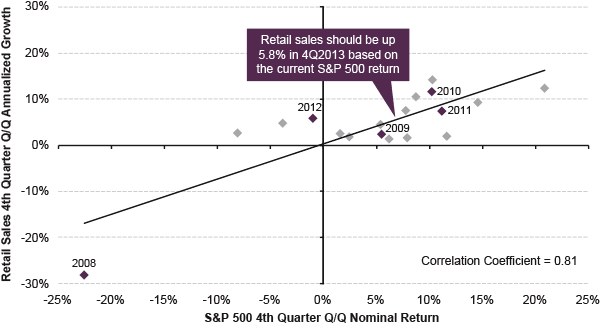As this bull market climbs its “wall of worry,” we can see its underlying strength. Valuation concerns and the risk of a major correction appear overblown, as we should see a continued rebound in economic fundamentals over the coming months.
Approaching December, it is worth taking a closer look at recent U.S. stock market performance for a clearer indication of where we might be headed. There has been much talk lately of 2013’s year-long equity rally, but taking a more granular view yields a more nuanced version of events. The U.S. stock market enjoyed gains during the first four months of 2013, but then, in the midst of the “rally,” between the highs of May and the lows of October, stocks posted a 1 percent loss and heightened volatility.
While that decline was by no means severe, markets don’t necessarily have to sell off to consolidate, they can just move sideways. So while some investors are still waiting for a correction, we have already seen at least one consolidation come and go. From the bottom in October up until today, the S&P 500 has rallied more than 9 percent. Now, after the magnificent gains starting in October and with the most recent retail sales data beating expectations, we head into the crucial holiday season with a lot of momentum.
As the old Wall Street adage goes, all bull markets climb a “wall of worry.” The current one appears to be no exception. The pattern of the stock market this year suggests that the current rally has a great deal of strength behind it. Concerns over valuations and the risk of a major correction appear overblown. Abundant liquidity and seasonal factors are now buoying the market, and as the effect of October’s U.S. government shutdown is flushed from the system, we should see a continued rebound in economic fundamentals in the coming months.
Equity Market Performance and U.S. Holiday Sales Outlook
Rising equity prices boost household net worth and translate into consumption via the so-called wealth effect. This relationship is particularly meaningful for the U.S. economy during the final quarter of the year. Historically, growth in fourth quarter retail sales, the holiday shopping season, has been closely related with equity performance during the same period. The expectation of higher U.S. equity prices due to abundant liquidity and low interest rates will likely support this year’s holiday sales.
S&P 500 4TH QUARTER RETURNS VS. RETAIL SALES 4TH QUARTER GROWTH

Source: Bloomberg, Guggenheim Investments. Data as of 11/25/2013.
This material is distributed for informational purposes only and should not be considered as investing advice or a recommendation of any particular security, strategy or investment product. This article contains opinions of the author but not necessarily those of Guggenheim Partners or its subsidiaries. The author’s opinions are subject to change without notice. Forward looking statements, estimates, and certain information contained herein are based upon proprietary and non-proprietary research and other sources. Information contained herein has been obtained from sources believed to be reliable, but are not assured as to accuracy. No part of this article may be reproduced in any form, or referred to in any other publication, without express written permission of Guggenheim Partners, LLC. ©2013, Guggenheim Partners. Past performance is not indicative of future results. There is neither representation nor warranty as to the current accuracy of, nor liability for, decisions based on such information. Past performance is not indicative of future results. There is neither representation nor warranty as to the current accuracy of, nor liability for, decisions based on such information.

